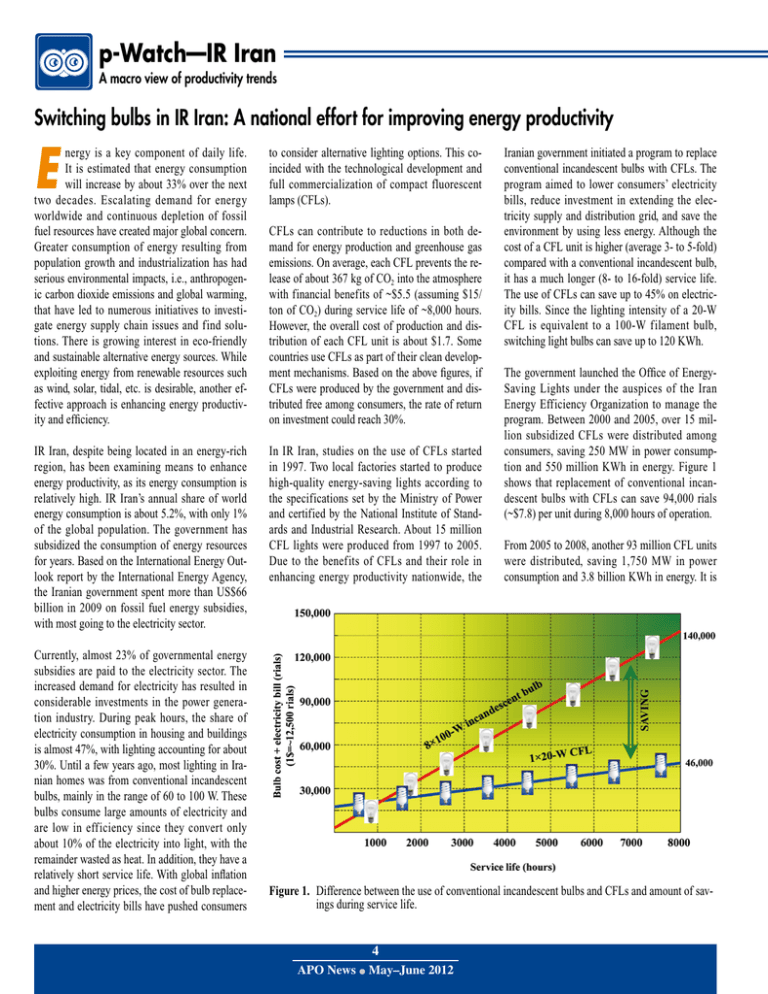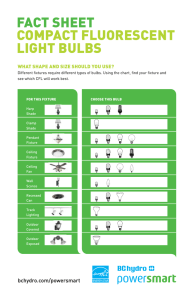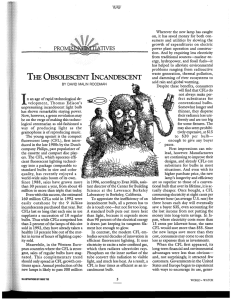p-Watch—IR Iran - Asian Productivity Organization
advertisement

alumnl news p-Watch—IR Iran A macro view of productivity trends Switching bulbs in IR Iran: A national effort for improving energy productivity E nergy is a key component of daily life. It is estimated that energy consumption will increase by about 33% over the next twoNPO decades. Escalating demand for energy focus and continuous depletion of fossil worldwide fuel resources have created major global concern. Greater consumption of energy resulting from population growth and industrialization has had serious environmental impacts, i.e., anthropogenic carbon dioxide emissions and global warming, that have led to numerous initiatives to investigate energy supply chain issues and find solutions. There is growing interest in eco-friendly and sustainable alternative energy sources. While exploiting energy from renewable resources such as wind, solar, tidal, etc. is desirable, another effective approach is enhancing energy productivity and efficiency. to consider alternative lighting options. This coincided with the technological development and full commercialization of compact fluorescent lamps (CFLs). IR Iran, despite being located in an energy-rich region, has been examining means to enhance energy productivity, as its energy consumption is relatively high. IR Iran’s annual share of world energy consumption is about 5.2%, with only 1% of the global population. The government has subsidized the consumption of energy resources for years. Based on the International Energy Outlook report by the International Energy Agency, the Iranian government spent more than US$66 billion in 2009 on fossil fuel energy subsidies, with most going to the electricity sector. In IR Iran, studies on the use of CFLs started in 1997. Two local factories started to produce high-quality energy-saving lights according to the specifications set by the Ministry of Power and certified by the National Institute of Standards and Industrial Research. About 15 million CFL lights were produced from 1997 to 2005. Due to the benefits of CFLs and their role in enhancing energy productivity nationwide, the Currently, almost 23% of governmental energy subsidies are paid to the electricity sector. The increased demand for electricity has resulted in considerable investments in the power generation industry. During peak hours, the share of electricity consumption in housing and buildings is almost 47%, with lighting accounting for about 30%. Until a few years ago, most lighting in Iranian homes was from conventional incandescent bulbs, mainly in the range of 60 to 100 W. These bulbs consume large amounts of electricity and are low in efficiency since they convert only about 10% of the electricity into light, with the remainder wasted as heat. In addition, they have a relatively short service life. With global inflation and higher energy prices, the cost of bulb replacement and electricity bills have pushed consumers CFLs can contribute to reductions in both demand for energy production and greenhouse gas emissions. On average, each CFL prevents the release of about 367 kg of CO2 into the atmosphere with financial benefits of ~$5.5 (assuming $15/ ton of CO2) during service life of ~8,000 hours. However, the overall cost of production and distribution of each CFL unit is about $1.7. Some countries use CFLs as part of their clean development mechanisms. Based on the above figures, if CFLs were produced by the government and distributed free among consumers, the rate of return on investment could reach 30%. Iranian government initiated a program to replace conventional incandescent bulbs with CFLs. The program aimed to lower consumers’ electricity bills, reduce investment in extending the electricity supply and distribution grid, and save the environment by using less energy. Although the cost of a CFL unit is higher (average 3- to 5-fold) compared with a conventional incandescent bulb, it has a much longer (8- to 16-fold) service life. The use of CFLs can save up to 45% on electricity bills. Since the lighting intensity of a 20-W CFL is equivalent to a 100-W filament bulb, switching light bulbs can save up to 120 KWh. The government launched the Office of EnergySaving Lights under the auspices of the Iran Energy Efficiency Organization to manage the program. Between 2000 and 2005, over 15 million subsidized CFLs were distributed among consumers, saving 250 MW in power consumption and 550 million KWh in energy. Figure 1 shows that replacement of conventional incandescent bulbs with CFLs can save 94,000 rials (~$7.8) per unit during 8,000 hours of operation. From 2005 to 2008, another 93 million CFL units were distributed, saving 1,750 MW in power consumption and 3.8 billion KWh in energy. It is Figure 1. Difference between the use of conventional incandescent bulbs and CFLs and amount of savings during service life. 4 APO News ● May–June 2012 by Dr. S. Saeid Hosseini tons of polluting gases into the atmosphere. estimated that switching bulbs under this program prevented emission of at least 2.8 million tons of greenhouse gases into the atmosphere. In addition, each CFL contributes almost 600,000 rials (~$50) to the national economy. After several CFL bulb distributions, the government is carrying out indepth analysis of environmental aspects and health and safety issues. Critics say that traces of mercury present in the bulbs cause environmental harm, which must be addressed. Currently, environmentally friendly LEDs with a longer service life are receiving attention. The Iranian government urges installation of CFLs in all governmental buildings, wherever technically possible. People become more interested in using CFLs as they learn more about the gains and benefits. Interest escalated after a new governmental act under which subsidies will be reduced gradually, including energy subsidies, and people will see hikes in electricity bills if no action is taken. Dr. S. Saeid Hosseini is Assistant Professor at Tarbiat Modares University and adviser to the National Iranian Productivity Organization. He received a BSc from Isfahan University of Technology and PhD in Chemical Engineering with specialization in energy and environmental technological solutions from the National University of Singapore. Among his interests are promoting joint academic-industry R&D through technological innovation to improve productivity. If half of Iranian households (currently almost 16 million) replaced three conventional 100-W bulbs with CFLs and assuming usage intensity of 60% during peak hours, almost 1,000 MW of power consumption could be saved, equivalent to an almost 1,300-MW saving in power generation. This is about $1.3 billion saved in additional investment for electricity generation. Assuming the release of 150g of noxious gases per kilowatt hour of electricity generated, the replacement plan will prevent the release of about 400,000 5 APO News ● May–June 2012




